FROM the pages of the September 1934 number of Sky Fighters:
Editor’s Note: We feel that this 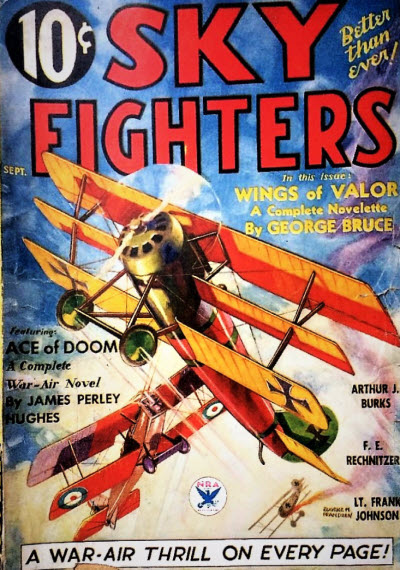 magazine has been exceedingly fortunate in securing Lt. Edward McCrae to conduct a technical department each month. It is Lt. Mcrae’s idea to tell us the underlying principles and facts concerning expressions and ideas of air-war terminology. Each month he will enlarge upon some particular statement in the stories of this magazine. Lt. MaCrae is qualified for this work, not only because he was a war pilot, but also because he is the editor of this fine magazine.
magazine has been exceedingly fortunate in securing Lt. Edward McCrae to conduct a technical department each month. It is Lt. Mcrae’s idea to tell us the underlying principles and facts concerning expressions and ideas of air-war terminology. Each month he will enlarge upon some particular statement in the stories of this magazine. Lt. MaCrae is qualified for this work, not only because he was a war pilot, but also because he is the editor of this fine magazine.
Ancestors of the Modern Planes
by Lt. Edward McCrae (Sky Fighters, September 1934)
I’VE been telling you rummies a whole lot about this and a little more about that from time to time. So I figure it’s about time I told you about some problems of the crates themselves. You should know, but more than likely you don’t, that up until the war started, airplanes were pretty darned crazy things at best, and people who thought they had common sense wouldn’t have anything to do with them. I remember when the newspapers all over America raised all kinds, of Cain because President Theodore Roosevelt risked his neck in one of those fool contraptions.
At the beginning of the war an airplane was a freak. The designs that inventors had worked out looked like the results of a nightmare. But a lot of them would fly in spite of their crazy-looking features. To put it straight, an airplane was a thing that was more likely to scare the enemy to death than to administer any physical damage to him.

Take a look at Fig.1. There the three pictures are of A—an Austrian ship, B—a Belgian ship and C—a British ship.
A Nightmarish-Looking Dingus
Now here’s an interesting angle about that third one of that little group. It is an early Avro. An Avro is a British ship that gets its name from its inventor, A.V. Roe. It’s a nightmarish-looking dingus, ain’t it?
Then listen, sisters and brothers, that was the granddaddy of a long and honorable line of ships that are going great guns yet today. I’ll admit that the present day Avro is a far cry from that box-kite looking thing in the picture. But it flew. And after all, Percival, you yourself are a far cry from your ancestors that hung by their tails from trees. Or are you?
Now, just when the soldiers got serious about shooting each other in the collar buttons and began to realize that this fracas wasn’t going to be just a big Rotary Club picnic, the boys with the brains stuck their noses over their blueprints and started figuring on force-feeding the awkward little birdies so their wings would get big and strong like they were eating their spinach every day.
Birds as Models
And naturally, when they figured what their problems were they showed what bright inventors they were by casting their eyes at the real birds. The results then, quickly made junk out of the crazy former models, and now all ships began to show a similarity in shape, even though they were designed in different countries and by people who didn’t know each other. See Fig. 2.

Two-A shows you the top view of the German Albatross made in 1914 and used by the Germans. Look at the wing-tips and the tail surfaces. Doesn’t the picture look like they had laid a bird down on the drafting board and traced its outline?
And what was going on in England at the same time? Look at Fig. 2-B. There’s a Handley-Page monoplane. That was used in the war, too.
Now compare their wings and tail surfaces. Don’t you see in their resemblance how they were both getting at the same idea, although not comparing ideas with each other?
Of course, in those days they didn’t have the powerful motors that were being developed and are in use now. And not having much power, their problem was to get strength enough in the wings and at the same time get the wings light enough for the weak motor to support.
Brace Wire
For that purpose, they resorted to using a lot of brace wire. Wire was light and strong so they used great quantities of it. I remember I was with a gang of flyers just up to a new field near Flanders in the early days and we just had got in a delivery of half a dozen new experimental ships that we were to try out. There were wires all over it. One of the boys said: “Gosh, I never thought I’d ever have to fly a wire chicken coop.”
But that was what they looked like, and they thought they had the problem solved. But, listen, tots, they didn’t. For just about then they learned something from the aviation engineers.
That was, that a wire vibrates crossways, and when it vibrates it offers just as much wind resistance as a flat edge of a hoard the width of the vibration!
In other words, if you had twenty wires stuck up and down between your wings and they vibrated two inches when the motor was running, you might just as well have braced your ship with twenty, two by fours with the narrow side facing the front. And what a lot of resistance that would cause. It would take a Cyclone motor to fight that and get any speed.
Let’s Watch the Albatross
So they started getting rid of wires wherever they could. And since we’ve started with an Albatross, let’s follow that baby through its stages of refinement. It was a good ship and once just about ruled the skies, so let’s watch a good ship grow up.

Look at Fig. 3. There’s your Albatross in 1915. Notice how much cleaner the lines are. But if you look closely and compare the trailing edge of the wings, especially around the outer extremities, you’ll see the same old design, although it has now become so modified that you’d hardly notice it if you weren’t looking for it.
But let’s go a step further. Look at 3-B. There she is in 1916-7. Still slicker. And, children, don’t let anybody tell you them wasn’t airyplanes for them days!
New Models—And Newer Ones!
So, you see, the powers behind the guns were throwing out new models faster than the automobile manufacturers do today. They wanted to have the very best airplanes they could get.
So, the engineers and manufacturers were busy night and day figuring out ways to improve the ships, and as soon as they got a new idea they would build a group of experimental ships and send them out with all the improvements for us to try out.
And since I mentioned experimental ships, it looks like a good chance to slip you a bit of information that might come in handy when you are looking at war crates. Whenever you saw a ship and the caption told you it was a Handley-Page S.E. 5, or a something else, R.E. 2, or whatever, did you ever wonder why they strung out that alphabet and numbers after the name of the ship just like a professor with a lot of A.B.’s and X.Y.Z.’s after his name? Well, here’s the dope.
Identification Letters
The British used a series of identifying type letters based on this system. Mons. Bleriot was credited with originating the tractor type airplane, so they designated the tractor types B.E. plus the number of the particular experiment of that company in building a tractor ship.
Farman was credited with originating the pusher type, and those types were Farman Experimental such-and-such a number, or F.E. 2’s or 3’s or whatever.
And also, they used other letters to indicate the duty for which the ship was to be tried out. Thus this table which you should always carry in the pocket of your Sunday pants:
B.E. was Bleriot Experimental.
F.E. meant Farman Experimental.
R.E. meant Reconnaissance Experimental.
S.E. meant Scouting Experimental.
And now I want you mugs to memorize all I’ve told you right quickly, or I’ll use EM on you, which means Eddie McCrae will experiment with breaking your heads.
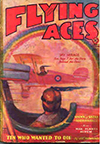 BELIEVE it or not, but many an airman on the Western Front got the fright of his young life by the mid-summer mirages that appeared every so often in the cloud-banked skies during the World War.
BELIEVE it or not, but many an airman on the Western Front got the fright of his young life by the mid-summer mirages that appeared every so often in the cloud-banked skies during the World War.





 magazine has been exceedingly fortunate in securing Lt. Edward McCrae to conduct a technical department each month. It is Lt. Mcrae’s idea to tell us the underlying principles and facts concerning expressions and ideas of air-war terminology. Each month he will enlarge upon some particular statement in the stories of this magazine. Lt. MaCrae is qualified for this work, not only because he was a war pilot, but also because he is the editor of this fine magazine.
magazine has been exceedingly fortunate in securing Lt. Edward McCrae to conduct a technical department each month. It is Lt. Mcrae’s idea to tell us the underlying principles and facts concerning expressions and ideas of air-war terminology. Each month he will enlarge upon some particular statement in the stories of this magazine. Lt. MaCrae is qualified for this work, not only because he was a war pilot, but also because he is the editor of this fine magazine.


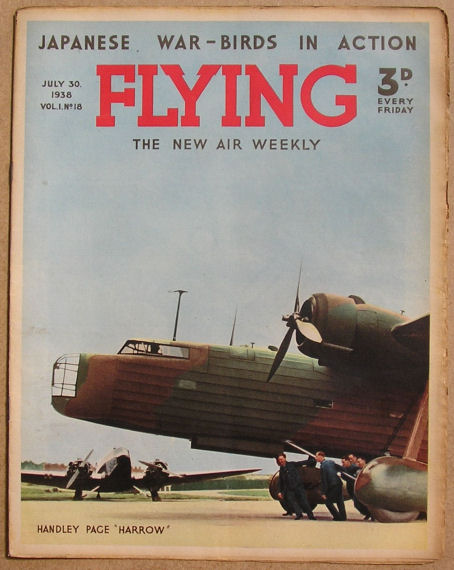 weekly paper of all things aviation, started up in England in 1938, amongst the articles and stories and photo features was an illustrative feature called “Heroes of the Air.” It was a full page illustration by S. Drigin of the events surrounding how the pictured Ace got their Victoria Cross along with a brief explanatory note.
weekly paper of all things aviation, started up in England in 1938, amongst the articles and stories and photo features was an illustrative feature called “Heroes of the Air.” It was a full page illustration by S. Drigin of the events surrounding how the pictured Ace got their Victoria Cross along with a brief explanatory note. 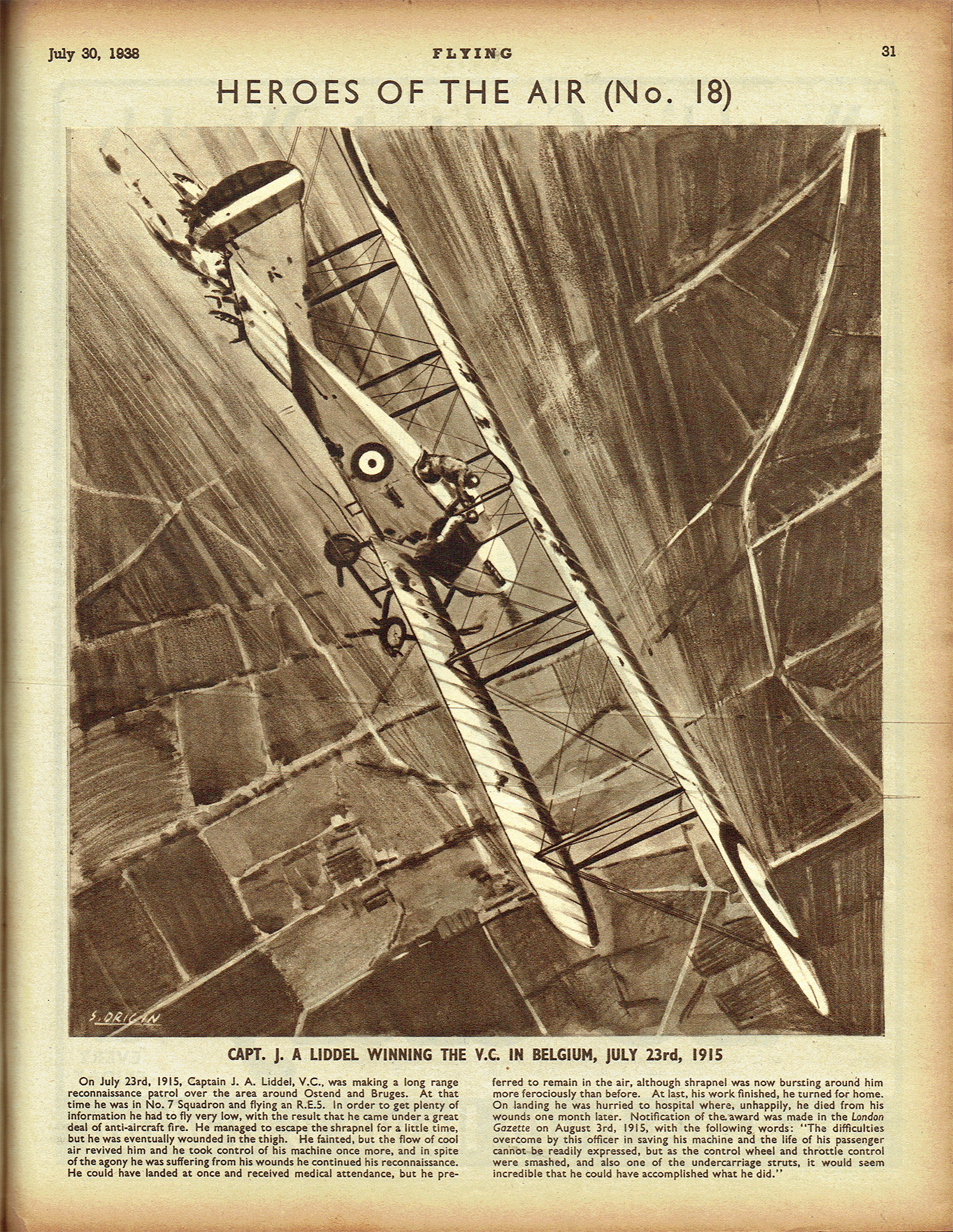
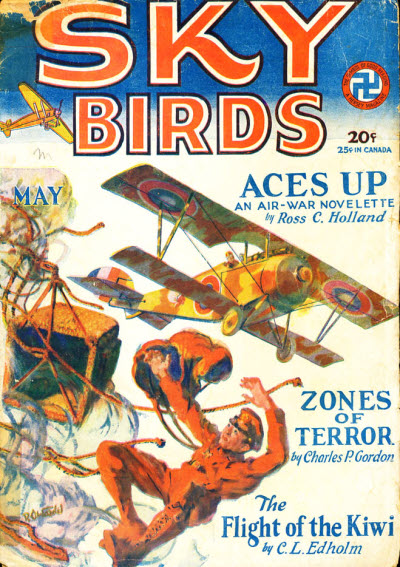 another story from one of the new flight of authors on the site this year—Andrew A. Caffrey. Caffrey, who was in the American Air Service in France during The Great War and worked for the air mail service upon his return, was a prolific author of aviation and adventure stories for both the pulps and slicks from the 1920’s through 1950. Here Caffrey tells the tale of Loop Murry, stunt flier for the movies who learns there’s sometime more to a man than meets the eye. From the May 1929 number of Sky Birds, it’s Andrew A. Caffrey’s “The Vanishing Ace!”
another story from one of the new flight of authors on the site this year—Andrew A. Caffrey. Caffrey, who was in the American Air Service in France during The Great War and worked for the air mail service upon his return, was a prolific author of aviation and adventure stories for both the pulps and slicks from the 1920’s through 1950. Here Caffrey tells the tale of Loop Murry, stunt flier for the movies who learns there’s sometime more to a man than meets the eye. From the May 1929 number of Sky Birds, it’s Andrew A. Caffrey’s “The Vanishing Ace!”